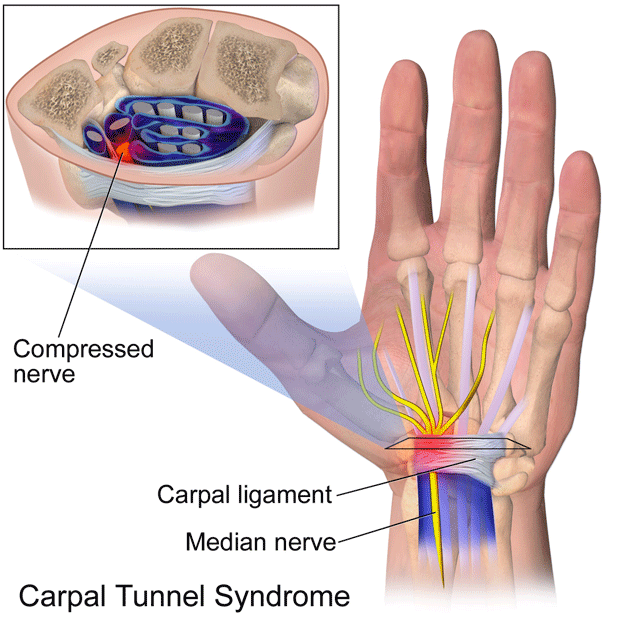
Mr W a 49 year old factory worker, complained to his GP of numbness and pins and needles in his arm. Read the full case here.
The carpal tunnel is a conduit in your wrist for the tendons that control the movement of your fingers, as well as the median nerve that controls the sensation and movement of your thumb, index finger, middle finger and half your ring finger.
A number of things can cause compression of the contents of the carpal tunnel. Conditions like thyroid disease, diabetes, arthritis and even pregnancy can cause carpal tunnel syndrome (CTS). Continuous repetitive movements of the wrist is a well-known cause and therefor it is often seen in factory workers (like Mr W), office workers and operators of machinery.
Symptoms explained
Because CTS affects the median nerve, the symptoms will be linked to the areas supplied by the median nerve. Pins and needles, weakness and pain are experienced in the first three fingers of the hand. Typically, the fifth finger (pinkie) is not involved. Symptoms typically start at night but can get worse throughout the day. A person suffering from CTS will also report that their grip is affected and may report difficulties picking up a mug of coffee.
A doctor will also ask about other symptoms and previous medical history to establish a possible cause for CTS, including include signs and symptoms of chronic conditions like diabetes.What the doctor will find on examination
On physical examination there are usually not a lot of specific signs. The power, tone and reflexes in the upper limb are often normal.
In long standing cases of CTS, the fleshy part of the thumb on the palm (thenar eminence), can be wasted. If the nerve supply to a muscle (as with the median nerve) is affected, the muscle it supplies can become atrophied.
Tinel’s sign: Tapping on the wrist can cause pins and needles to appear in the hand and fingers.
Phalen’s test: With flexion of the wrists, paraesthesia (pins and needles) may be felt in the hands and fingers if CTS is present.
It is important to note that the final diagnosis is usually made after special investigations like X-rays to check for bony abnormalities; blood tests to check for underlying causes like diabetes or thyroid disease; and ultrasound to check the size of the median nerve (which will increase if compressed).
Image: Anatomy of the carpal tunnel showing the median nerve passing through the tight space it shares with the finger tendons. Source: Blausen.com staff. "Blausen gallery 2014". Wikiversity Journal of Medicine

How is carpal tunnel syndrome treated?
The most obvious answer is that the causative factor should be attended to. Treating the underlying cause might solve the problem. If a mechanical cause like repetitive movements is to blame, avoiding such movements may ease the symptoms. Referral to a physiotherapist and occupational therapist is essential to assist with mobilisation, exercises and splints.
The doctor might also prescribe non-steroidal anti-inflammatory medication to help ease pain and discomfort.
If all conservative management options are exhausted, surgery may be considered. During the surgery, the sheath covering the carpal tunnel is cut open to relieve compression and pressure in the carpal tunnel.
This procedure is called a median nerve release. The success of the surgery cannot be predicted with certainty. Many patients are symptom free after the surgery while others still experience symptoms.
Previously on What's Your Diagnosis?
What's your diagnosis - Case 1: vomiting and weight loss
What's your diagnosis - Case 2: eye pain
What's your diagnosis - Case 3: strange behaviour and a bullet in the back
What's your diagnosis - Case 4: seeing odd things
What's your diagnosis - Case 5: mysterious lungs
What's your diagnosis - Case 6: runner with seizures
What's your diagnosis - Case 7: swollen knee
What's your diagnosis - Case 8: bloody semen
What's your diagnosis - Case 9: confusing neurological signs
What's your diagnosis - Case 10:diabetic teenager with unusual signs and symptoms
What's your diagnosis - Case 11:bruising with no apparent cause
What's your diagnosis - Case 12: severe tummy pain
What's your diagnosis - Case 13: severe sore throat
What's your diagnosis - Case 14:abdominal pain and swelling
What's your diagnosis - Case 15: the world is spinning
Image: Women holding her wrist from Shutterstock




 Publications
Publications
 Partners
Partners














